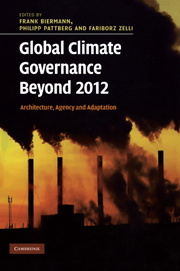Book contents
- Frontmatter
- Contents
- List of contributors
- Preface
- List of abbreviations
- 1 Global climate governance beyond 2012
- Part I Architecture
- Part II Agency
- 9 Agency in global climate governance
- 10 The role and relevance of networked climate governance
- 11 Carbon market governance beyond the public–private divide
- 12 A staged sectoral approach for climate mitigation
- 13 Technological change and the role of non-state actors
- Part III Adaptation
- Index
- References
11 - Carbon market governance beyond the public–private divide
Published online by Cambridge University Press: 05 July 2014
- Frontmatter
- Contents
- List of contributors
- Preface
- List of abbreviations
- 1 Global climate governance beyond 2012
- Part I Architecture
- Part II Agency
- 9 Agency in global climate governance
- 10 The role and relevance of networked climate governance
- 11 Carbon market governance beyond the public–private divide
- 12 A staged sectoral approach for climate mitigation
- 13 Technological change and the role of non-state actors
- Part III Adaptation
- Index
- References
Summary
Introduction
Despite current disagreements over the future climate policy architecture, carbon markets represent a central feature in most proposals to move society towards a low carbon economy. The worldwide creation of carbon markets is emblematic of the marketization trend in climate governance that accelerated after Russia’s ratification of the Kyoto Protocol in November 2004 – the crucial moment making the treaty legally binding. With the entry into force of the Kyoto Protocol, the inception of the EU emissions trading scheme in 2005 and the more recent emergence of regional carbon markets in North America, Australia and New Zealand, global transactions in emission reductions have become more than mere social imagining. As estimated by the World Bank (Capoor and Ambrosi 2008: 1), as much as 2983 million tonnes of carbon dioxide were traded by public and private actors in 2007 to a total value of USD 64 035 million.
In this chapter, we illustrate the agency beyond the state in contemporary carbon markets. However, in contrast to global governance studies (Rosenau 1999; Biersteker and Hall 2002), we do not conceptualize carbon market governance along the public–private continuum. Instead of asking which entities (for example public or private authorities) govern the carbon economy, we draw attention to the procedures by which carbon markets are made thinkable and operational as administrative domains in the first place. Hence, we analyse the complex body of knowledge, techniques and practices that have turned tradable carbon offsets into a governable reality. In particular, this chapter focuses on the multilateral verification, validation and certification practices of the Clean Development Mechanism (CDM) that have enabled the making of the ‘certified emission reduction’, and the private rules and standard-setting underpinning ‘voluntary’ or ‘verified emission reductions’.
- Type
- Chapter
- Information
- Global Climate Governance Beyond 2012Architecture, Agency and Adaptation, pp. 165 - 182Publisher: Cambridge University PressPrint publication year: 2010
References
- 11
- Cited by



